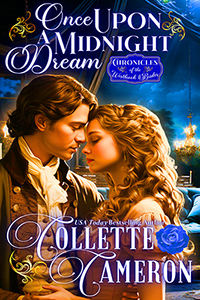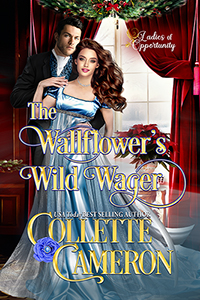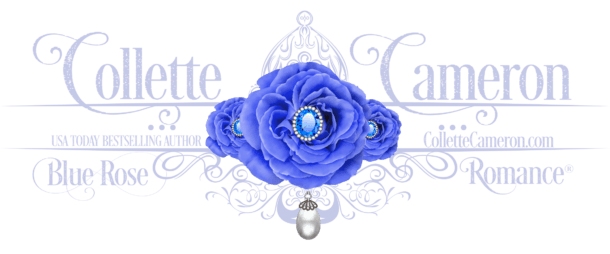In my debut Regency romance, Deflowering Daisy, several important scenes in the book take place in the arbor of an extensive rose garden. This rose garden was the creation of the previous lady of the estate, whose husband, a captain in the Royal Navy, brought new rose plants back to his beloved wife from many of his voyages. His lady planted them in a rose garden she designed and tended as a tangible and living reminder of their love when he was
away from her.
Early in the story, that rose garden is compared with the most famous rose garden in the
world at the time, that created by the Empress Joséphine at her magnificent country home, the Château de Malmaison, outside Paris. In keeping with the lovely surroundings here at Blue Rose Romance, with all these elegant and romantic blue roses, I thought I would tell
you something you might not know about that impressive royal rose garden.
Today, many people think of the rose as a quintessentially English flower, and there were roses in England at least as far back as the Middle Ages. In fact, many of the most popular roses were first brought into Europe by the Crusaders when they returned from the wars in the Holy Land. Curious that men who would rather wield a sword than give a woman a flower would make the effort to bring these new plants back to Europe. The truth is, those sword-swinging knights brought roses back with them for one rather unromantic reason, they had high profit potential. Several varieties of rose had medicinal and culinary
properties and even more of them were considered valuable for the fragrance which could be extracted from their petals. At that time, only a very few people cared about the appearance of the flowers.
These old, sometimes wild, roses were strong and study and their shrubs were much larger than the rose bush shrubs with which we are familiar today. These hardy roses could grow even in very poor conditions, with little or no attention. They typically had a single short blooming period per year, but they often put on many flowers at once and all those blooms were very fragrant. And, after flowering, they would yield rose hips, which were used for a number of culinary and medicinal purposes. Though many of these roses were quite pretty, they were still more often cultivated for their fragrant petals from which the very valuable attar of roses was made, and for their tasty and healing hips.
By the eighteenth century, tea roses from China were also being imported into Europe. But unlike those earlier roses, they were cultivated as much for their striking appearance as they were for their other properties. However, these new imported roses were very rare and thus extremely costly. Only the wealthiest among a small group of dedicated rose fanciers could afford to own them. But at that time, most of those rose fanciers lived in France, only a handful were to be found in England.
As the eighteenth century came to a close, a woman who had been named after these lovely flowering plants was in a position to cultivate as many of them as she pleased, simply for their beauty. And she had the power to have rose plants from all over the world brought to
her, even through the British blockade of French ports. Born in Martinique, this baby girl was christened Marie Josèphe Rose Tascher de La Pagerie, but was called Rose by her family. When one of her younger sisters died, Rose was sent off to France to marry the aristocrat to whom her sister had been promised. The marriage was not a happy one, and it ended violently when Rose’s husband lost his life to the guillotine during the Reign of Terror. Rose herself was also scheduled to be executed, but was spared by the fall and death of Maximilien Robespierre just days before she would have taken a ride in the tumbril.
A beautiful young widow with two children and limited resources, Rose had affairs with some of the most powerful men at the highest levels of French government in order to support herself and her family. In 1795, she met Napoleon Bonaparte, a rising star on the stage of French politics and became his mistress. The young general fell madly in love with her and they were married the following year. However, Rose’s ambitious husband thought her name too plain and ordinary. As he would do with a number of his women over the years, he re-christened her Joséphine, a name he thought more appropriate for the consort of the man of power he intended to become. Therefore, when he crowned himself Emperor in 1804, his wife became the Empress Joséphine. As such she has come down in history, despite the fact that she lived the majority of her life as Rose.
In 1799, while her husband was away in Egypt with the French army, Joséphine purchased a run-down country estate on the out-skirts of Paris, the Château de Malmaison. The price for the estate was substantial, and coupled with the costs of restoring and refurbishing the property, it was exorbitant. But, though Napoleon was very angry with his wife when he first learned of this purchase, he was still in love with her and eventually forgave her. He decided he could put the property to use as a horse stud, but he reckoned without his wife’s determination. She may have been deprived of her name, but she was determined to surround herself with her favorite flower.
By 1804, Joséphine had become a serious student of botany. She had also come to realize that France would never be able to compete with England in heavy industry, but they could compete in the area of luxury goods. The Empress decided she could use her influence to cultivate all manner of exotic plants in her extensive gardens at Malmaison, and make them fashionable across the Continent. Closest to her heart were roses, and she was determined to have at least one plant of every known variety of rose in her garden. Her husband gave orders that any ship or port seized by French naval forces was to be searched for exotic plants and seeds, especially roses. Anything found was to be sent home to Malmaison for the Empress. Joséphine hired an English gardener, for though the best rose breeders were French, it was acknowledged that the English were better gardeners. Most of the eminent rose breeders in France became acquainted with the Empress, and she allowed them to take
cuttings of her rose plants for use in their rose breeding programs. Thus, the magnificent rose collection at Malmaison became the basis for nearly all modern-day roses.
Despite the fact that the roses in the gardens of Malmaison were the foundation of many roses we all enjoy today, few of those living in the twenty-first century would be able to recognize any of the roses which had been cultivated under the direction of the French Empress. For most of the roses in that garden were what are known today as “old” roses, also known as antique or heirloom roses. The tea rose of China had not yet made deep inroads into this rose stock, and it was from the Chinese “stud” roses that the colors of true red and yellow were derived, some decades later. The color range of the old roses ran from white to a very deep pink, with many variations in shade in between. There were pure white roses, cream roses with just a hint of yellow near the center, and many pinks, from the very
palest blush pink to the deepest fuchsia. There were also roses with a range of warmer pinks from salmon and coral to nearly orange. But there would have been none of the purple to lavender shades of roses we know today, those were also bred later in the nineteenth century. Records suggest that Joséphine did have at least one red China rose in her garden. If that is true, it would have been a rare and exciting rose which would have fascinated her visitors. But there would have been no true yellow rose, since the first yellow rose was not introduced until 1837. Nor were there any blue roses in the gardens of Malmaison, for, as Collette has explained in her article on blue roses, no species of rose has the genetic material
necessary to produce a truly blue flower. One collector of old roses has characterized the difference between the old roses and the brightly-colored modern roses as that between a reserved young miss and a tart. The reserved young lady flirts with you subtly, shyly, while the tart exposes all she has, leaving nothing to the imagination.
Though the variety of the color of rose blooms in the gardens at Malmaison would have been more limited than the colors we see today, the fragrance of Joséphine’s roses were nearly unlimited. There were many roses which had a fragrance very like what we today consider the classic scent of a rose. But there were also musk roses, roses that smelled of fruits like raspberries, lemons and pineapple, and even roses that smelled like other flowers, such as violets and nasturtium and still others which smelled of spices, such as clove and cinnamon. Typically, the deeper the pink color of the rose, the more likely it would smell like a classic rose. White and cream roses smelled more like other flowers, while the more orange the rose, the more likely it would
have a spicy fragrance. The fragrances of these old roses were most powerful early in the morning, before the bloom was heated by the sun. But even later in the afternoon, the fragrances of these roses was much stronger than the fragrances of most of our modern hybrid roses. As roses were bred for more and deeper colors in a broader range, the power of their fragrance has often been bred out of them. Today, one usually has to put one’s nose very close to a rose blossom in order to enjoy its fragrance. In the gardens at Malmaison, the fragrance of Joséphine’s roses could be enjoyed even a few feet away from the rose.
The Empress Joséphine prized both color and fragrance in her roses. Records show that she considered their placement in the garden based both on the color and the fragrance of their blossoms in order to provide an enjoyable experience to her family and visitors when they strolled through her gardens. The Empress cultivated many plants in her garden in addition to roses. Because of the size and the potent fragrances of the majority of her roses, she made it a point to plant them at some distance from each other so that they did not overwhelm those who were walking along the paths of her gardens. Most old roses, such as those which Joséphine cultivated at Malmaison, did not bloom for several months, as do many modern roses. Rather, they tended to bloom in the spring, for a short span of just a few weeks. But during that time, each plant produced many dozens of blooms. Old rose plants were taller and stronger than most modern rose shrubs, so they could support the weight of this
abundant flowering. This also meant the roses reached much higher than we would see today, with the exception of climbing roses.
Now, imagine that you are a guest of the Empress Joséphine at Malmaison in the spring, at the height of the rose blooming season. You have gone out into her magnificent gardens early in the morning, when the dew is still on the roses and their fragrances are fresh and potent. As you walk along the garden paths, you approach large roses bushes planted here and there along your way, each laden with many blossoms in a range of soft colors from white to deep pink. The rich fragrance of each rose wafts to you on a light breeze even before you come close to the bush and fills the air around you with floral, fruity and spicy scents. Is it any wonder that Joséphine’s daughter considered the gardens at Malmaison a most “delicious spot.”
Though the rose garden at Kesteven Lodge, the setting for much of the story in Deflowering Daisy, is not as extensive as that of the Château de Malmaison, it is still larger than many English rose gardens at the time. There are a number of walkways through the garden and a large arbor covered with climbing roses along one side. It is in this arbor that Daisy is enflowered by the hero, David. The roses in this garden would have been large, fragrant old roses, just like those at Malmaison. A lovely setting for romance.
The Regency Redingote
www.kathrynkane.net
















